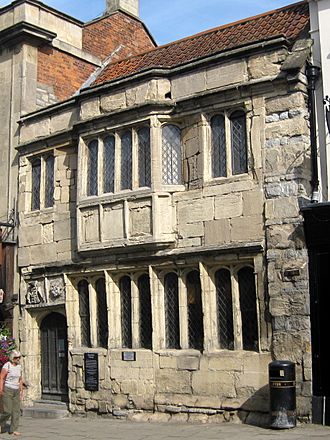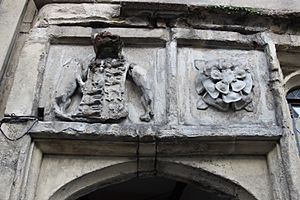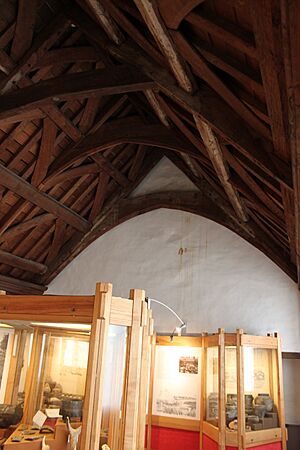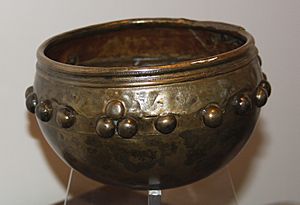The Tribunal, Glastonbury facts for kids
Quick facts for kids The Tribunal |
|
|---|---|
 |
|
| General information | |
| Town or city | Glastonbury |
| Country | England |
| Coordinates | 51°8′51.58″N 2°43′1.68″W / 51.1476611°N 2.7171333°W |
| Construction started | 15th century |
| Completed | 16th century |
The Tribunal is an old building in Glastonbury, Somerset, England. It was built a long time ago, in the 1400s. It was first a home for a rich merchant. Today, it is a special historic building. It is called a Grade I listed building, which means it is very important.
We do not know everything about its past. But most of the stone house you see now was built in the 1400s. It stands where a wooden building from the 1100s once was. The front wall was added later. Over the years, it has been many things. It was a shop, a school, and even a place where nuns lived. People once thought it was a court, which is why it is called "The Tribunal." However, there is no proof this ever happened.
Today, English Heritage looks after the building. It also has a museum inside. This museum shows amazing old items from Glastonbury. It includes things found at the Glastonbury Lake Village. The local town council runs the museum.
The Tribunal's Story

The Tribunal got its name by mistake. People thought it was where the old Glastonbury Abbey held its courts. These courts handled local justice. A writer named John Collinson might have first used the name in 1791. But later, in 1826, another person could not find out where the name came from. Some also believed it was a site for famous trials after a rebellion.
The building we see today was built in the 1400s. It replaced an older wooden building from the 1100s. In the 1500s, a new front was added to the original building. It is possible that the stone and windows for this front came from the Abbey itself. Old drawings show similar features.
The main door is very old and original. Above it, you can see the royal arms and a Tudor rose. This is a special symbol from English history. The building might have been a place for travelers or sick people long ago. Later, in the 1700s, it was a school for young gentlemen. Now, English Heritage cares for it. Glastonbury Town Council helps manage the museum inside.
Building Design
The Tribunal has two main rooms on the ground floor. There is also a kitchen attached. A staircase connects these rooms to the living areas upstairs. The front room on the ground floor might have been a shop at first. But it stopped being a shop after the new front wall was added in the 1500s. This room has special spaces on each side of its arched fireplace.
The back room on the ground floor was the main hall. It still has its original ceiling panels from the 1500s. It also has a window with four sections. The ceiling has beautiful plaster decorations from the Elizabethan era. This was also when the kitchen part was added.
The wooden stairs leading upstairs replaced older stone stairs. You can still see parts of the old stone stairs in the walls. The front room upstairs was once divided. But it became one larger space when the new front wall was built. Its roof has special arched wooden supports called trusses. The back room upstairs still has parts of a large fireplace. However, its chimney was blocked when the downstairs fireplace was put in.
Glastonbury Museum at the Tribunal
The Tribunal building is now home to the Glastonbury Museum at the Tribunal. This museum displays many interesting items. Some are from the town's history. Others are from the Iron Age Glastonbury Lake Village. This village was a "crannog" or man-made island. It was built on the Somerset Levels near Godney. This is about 3 kilometers northwest of Glastonbury. The village was about 120 meters long and 90 meters wide.
The village was built around 300 BC. People lived there until about 100 AD. It was then left, possibly because water levels rose. The village was built on a swamp. It had a base of timber, brushwood, and clay. About 100 people lived there in five to seven groups of houses. Each group was for a large family. There were also sheds and barns. The buildings were made of hazel and willow covered with reeds. A wooden fence often surrounded the village. At its busiest, it might have had 15 houses and up to 200 people.
The museum shows many cool things. One is the metal "Glastonbury Bowl." It was made from two parts joined together. It was repaired many times. The bottom part was made in the Iron Age. The top part was added later, around the 1st century. It might have been from another metal object.
Other items from the village include a clay part from bellows. There are also whetstones and iron knives. You can see iron currency bars too. These were like tokens used to trade for goods. Some original storage jars are also on display. These were put back together by Arthur Bulleid. He found the village site in 1892. In the old kitchen at the back of the building, there is an Iron Age log canoe. It was found near the lake village.
The Glastonbury Town Council runs the museum. The Glastonbury Antiquarian Society helps set up the exhibits.
See also
- Grade I listed buildings in Mendip




